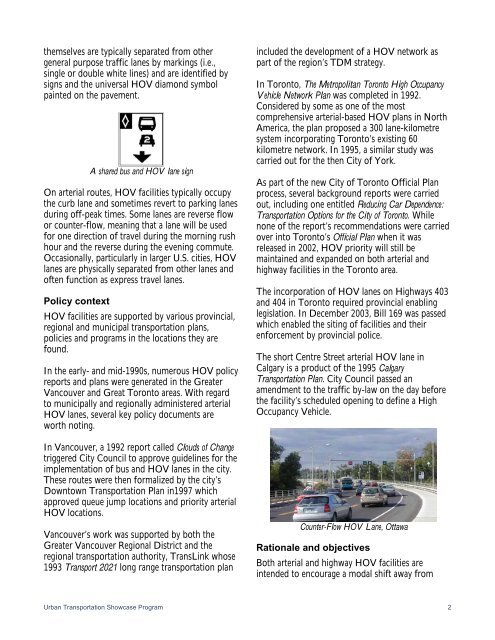High Occupancy Vehicle Lanes in Canada
High Occupancy Vehicle Lanes in Canada
High Occupancy Vehicle Lanes in Canada
Create successful ePaper yourself
Turn your PDF publications into a flip-book with our unique Google optimized e-Paper software.
themselves are typically separated from other<br />
general purpose traffic lanes by mark<strong>in</strong>gs (i.e.,<br />
s<strong>in</strong>gle or double white l<strong>in</strong>es) and are identified by<br />
signs and the universal HOV diamond symbol<br />
pa<strong>in</strong>ted on the pavement.<br />
A shared bus and HOV lane sign<br />
On arterial routes, HOV facilities typically occupy<br />
the curb lane and sometimes revert to park<strong>in</strong>g lanes<br />
dur<strong>in</strong>g off-peak times. Some lanes are reverse flow<br />
or counter-flow, mean<strong>in</strong>g that a lane will be used<br />
for one direction of travel dur<strong>in</strong>g the morn<strong>in</strong>g rush<br />
hour and the reverse dur<strong>in</strong>g the even<strong>in</strong>g commute.<br />
Occasionally, particularly <strong>in</strong> larger U.S. cities, HOV<br />
lanes are physically separated from other lanes and<br />
often function as express travel lanes.<br />
Policy context<br />
HOV facilities are supported by various prov<strong>in</strong>cial,<br />
regional and municipal transportation plans,<br />
policies and programs <strong>in</strong> the locations they are<br />
found.<br />
In the early- and mid-1990s, numerous HOV policy<br />
reports and plans were generated <strong>in</strong> the Greater<br />
Vancouver and Great Toronto areas. With regard<br />
to municipally and regionally adm<strong>in</strong>istered arterial<br />
HOV lanes, several key policy documents are<br />
worth not<strong>in</strong>g.<br />
In Vancouver, a 1992 report called Clouds of Change<br />
triggered City Council to approve guidel<strong>in</strong>es for the<br />
implementation of bus and HOV lanes <strong>in</strong> the city.<br />
These routes were then formalized by the city’s<br />
Downtown Transportation Plan <strong>in</strong>1997 which<br />
approved queue jump locations and priority arterial<br />
HOV locations.<br />
Vancouver’s work was supported by both the<br />
Greater Vancouver Regional District and the<br />
regional transportation authority, TransL<strong>in</strong>k whose<br />
1993 Transport 2021 long range transportation plan<br />
<strong>in</strong>cluded the development of a HOV network as<br />
part of the region’s TDM strategy.<br />
In Toronto, The Metropolitan Toronto <strong>High</strong> <strong>Occupancy</strong><br />
<strong>Vehicle</strong> Network Plan was completed <strong>in</strong> 1992.<br />
Considered by some as one of the most<br />
comprehensive arterial-based HOV plans <strong>in</strong> North<br />
America, the plan proposed a 300 lane-kilometre<br />
system <strong>in</strong>corporat<strong>in</strong>g Toronto’s exist<strong>in</strong>g 60<br />
kilometre network. In 1995, a similar study was<br />
carried out for the then City of York.<br />
As part of the new City of Toronto Official Plan<br />
process, several background reports were carried<br />
out, <strong>in</strong>clud<strong>in</strong>g one entitled Reduc<strong>in</strong>g Car Dependence:<br />
Transportation Options for the City of Toronto. While<br />
none of the report’s recommendations were carried<br />
over <strong>in</strong>to Toronto’s Official Plan when it was<br />
released <strong>in</strong> 2002, HOV priority will still be<br />
ma<strong>in</strong>ta<strong>in</strong>ed and expanded on both arterial and<br />
highway facilities <strong>in</strong> the Toronto area.<br />
The <strong>in</strong>corporation of HOV lanes on <strong>High</strong>ways 403<br />
and 404 <strong>in</strong> Toronto required prov<strong>in</strong>cial enabl<strong>in</strong>g<br />
legislation. In December 2003, Bill 169 was passed<br />
which enabled the sit<strong>in</strong>g of facilities and their<br />
enforcement by prov<strong>in</strong>cial police.<br />
The short Centre Street arterial HOV lane <strong>in</strong><br />
Calgary is a product of the 1995 Calgary<br />
Transportation Plan. City Council passed an<br />
amendment to the traffic by-law on the day before<br />
the facility’s scheduled open<strong>in</strong>g to def<strong>in</strong>e a <strong>High</strong><br />
<strong>Occupancy</strong> <strong>Vehicle</strong>.<br />
Counter-Flow HOV Lane, Ottawa<br />
Rationale and objectives<br />
Both arterial and highway HOV facilities are<br />
<strong>in</strong>tended to encourage a modal shift away from<br />
Urban Transportation Showcase Program 2
















